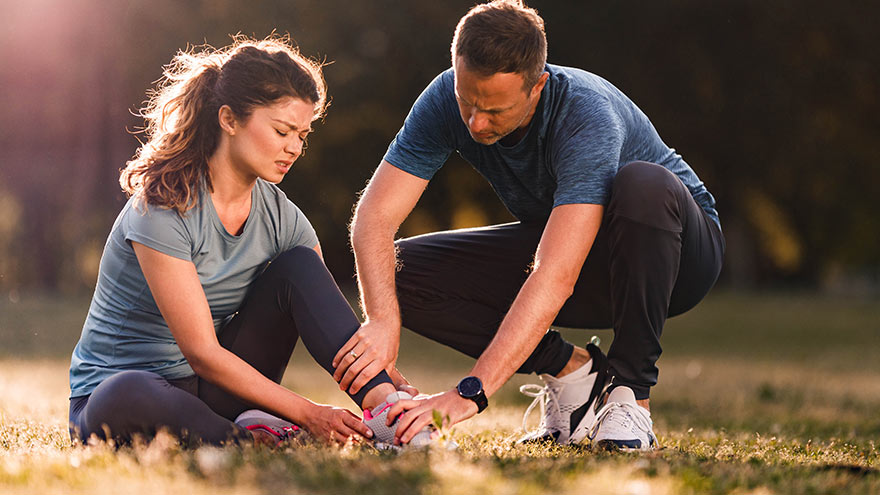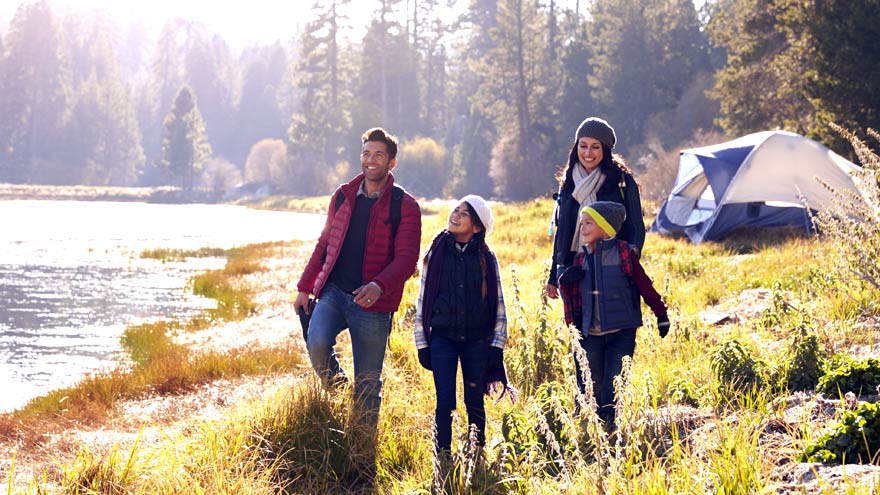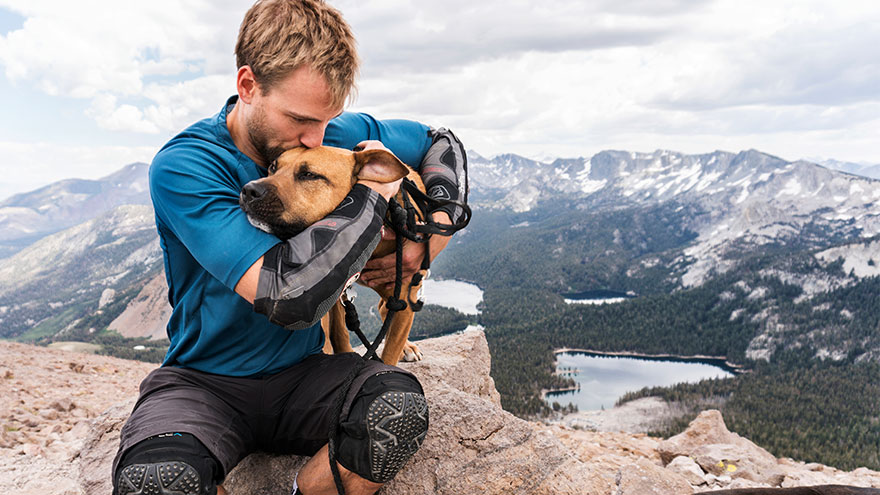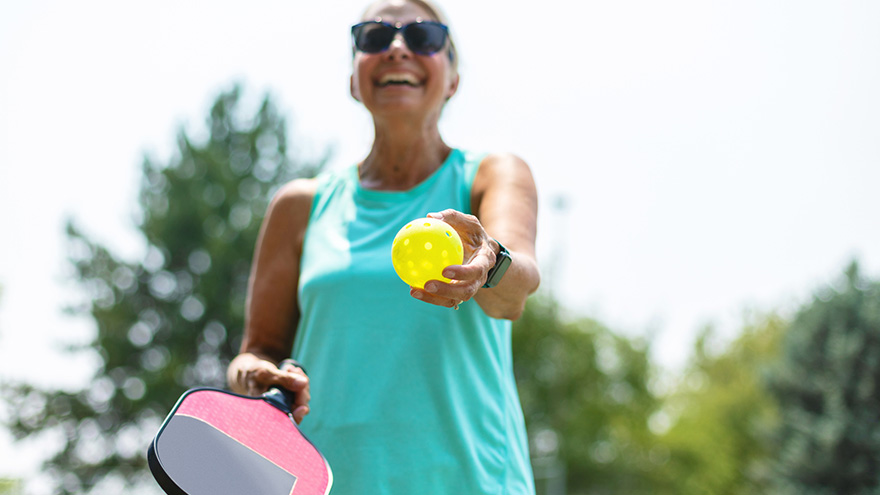Search
Results for 'what is an'
Clear-
How to Treat a Sprain or Strain
Injuries happen to everyone. They are caused by participating in sports, recreational activities like hiking, and even by accidentally stepping off a curb wrong. If you experience a sprain or strain, the first few days are often the most painful. Renown Sports Medicine physicians Luis Palacio, MD and Brandon Hockenberry, MD walked us through what to do after an injury. Listen to Your Body See a medical professional right away if: You know or suspect that a bone is broken You are having difficulties putting full weight on a joint of the leg Pain or swelling is severe There is a sign of an infection, such as redness and warmth in the joint The First 24-72 Hours Joint sprains tend to swell more than muscle strains. You can use ice as needed for comfort and to relieve any pain, but do not use ice for more than 15-20 minutes at a time. Ice and NSAIDs (such as ibuprofen) can help prevent excessive swelling and mask the pain, but they do not speed recovery. Some research shows that overuse of ice actually delays recovery. During the first 24-72 hours, your injury will go through an inflammation phase. Inflammation is your body’s natural way to dispose of dead tissue cells, build new healthy structures, and hopefully heal even stronger than before.
-
The Not-So-Fab-Five: Foods That Increase Stroke and Heart Disease Risk
Did you know that 80 percent of all strokes are preventable? Learn which foods should be eaten in moderation to reduce your family's risk of stroke. Stroke is the fifth leading cause of death in the nation and a major cause for disability, killing 130,000 people each year. But did you know that 80 percent of all strokes are preventable, according to the American Stroke Association? Several stroke risk factors -- high blood pressure, smoking, diabetes, physical activity level, obesity, high cholesterol and heart and artery disease -- can be controlled, treated and improved, right down to the foods we choose to consume each day. Diets high in sodium can increase blood pressure, putting you at greater risk for stroke. A high-calorie diet can lead to obesity -- another risk factor. And foods high in saturated fats, trans fat and cholesterol will raise your blood cholesterol levels causing blood clots, which -- you guessed it -- can lead to a stroke. The “not-so-fab” five foods listed below play a large role in damaging your body and causing vascular disease, stroke and heart disease and should be avoided on a regular basis. However: Moderation is the key to life, in my opinion. Sure, everyone is going to have a soda here and there or a steak off the grill, but keep it off the main menu. 1. Packaged and Fried Food Have you noticed foods like hot dog buns and bottled salad dressings rarely go bad? Ever asked yourself why? This is due to the use of hydrogenated oils, which are trans fats. Hydrogenated oils stay solid at room temperature and do not require refrigeration. Convenient? Yes. Healthy? No. Unfortunately, many frozen foods and meals also fall into this category, except for frozen fruits and veggies. So here’s the lowdown on trans fats: They’re considered by many experts as the worst type of fat you can consume, raising your LDL (“bad”) cholesterol and lowering your HDL (“good”) cholesterol. While some meat and dairy products contain small amounts of naturally occurring trans fat, most dietary sources are formed through an industrial process adding hydrogen to vegetable oil, causing the oil to solidify at room temperature. The FDA is in the process of restricting or possibly banning trans-fats from food in the U.S. A study published in JAMA Cardiology compared data from counties with and without trans-fat restrictions and the findings were substantial: There was a 6 percent decline in hospitalizations for heart attack and stroke in counties with trans-fat restrictions. Bottom line: Ideally no processed food should pass your lips, but realistically, aim for less than 2 grams of trans fat per day. Skip the store-bought treats at the office and fries at lunch. Also avoid crackers, regardless of what you are dipping them in. Choose to eat fruits to satisfy your sweet cravings and veggies and hummus to satisfy the savory. 2. Lunch meat Processed meats, including bacon, smoked meats and hot dogs, are all on the DNE (Do Not Eat) list, unless you want to play with fire. Processed meats are a no-go if you want to keep your arteries clear of plaque buildup. So what is the alternative to your salami sandwich? Try a healthy alternative like a tuna sandwich with avocado (a great alternative to mayo) or a veggie sandwich. 3. Diet soft drinks First of all, when a drink is sweeter than a candy bar but it contains zero sugar and zero calories, buyer beware. Many consumers think because a soda is labeled “diet” it’s a better choice, but studies have linked diet soft drink consumption with an increased risk of stroke and vascular disease. In a nine-year study of more than 2,500 people, those who drank diet soda daily were 48 percent more likely to have a heart attack or stroke or die from those events, compared with those who rarely or never drank soda. What else are you supposed to drink? If you must drink soda, break the everyday habit and drink it on special occasions; otherwise water rules. And if you don’t like water, try flavoring your water with fruit slices. 4. Good-old red meat So is there ANY good meat out there you ask? The answer is yes, but it’s not red. In the journal Stroke, an article showed women who consumed large servings of red meat regularly had a 42 percent higher incidence of stroke. Red meat is high in saturated fat, which clogs arteries with plaque. The alternative to red meat is a heart-healthy protein like poultry or fish, or even non-animal products like beans, nuts and tofu. 5. Canned foods Steer clear of factory processed soups, beans and sauces. Canned items all have incredible amounts of sodium or MSG or baking soda/powder to maintain their freshness and shelf life. One study showed if you consume more than 4,000 mg of salt per day, you more than double the risk of stroke compared to diets with less than 2,000 mg. Another tip: When possible, plan and make meals from scratch. Making the wrong meal or snack choices is one of the biggest contributing risk factors for stroke and heart disease. Most people know what good food choices are, but they don’t realize the serious impact the bad choices have on overall health. Learn what is most beneficial to your body to consume. It will be a life changer – literally.
Read More About The Not-So-Fab-Five: Foods That Increase Stroke and Heart Disease Risk
-
Powerlifting through MS Diagnosis
When Tabitha Cox received a diagnosis of multiple sclerosis (MS), she was in shock, denial and felt that she was too strong for something like this to be happening to her. As the disease progressed, Tabitha realized she needed to do what she could to stay as healthy as possible. “I heard, ‘You have a quarter-size lesion on your brain,'” recalls Tabitha Cox. “At that moment, that was literally all I heard come out of her mouth.” Tabitha’s official diagnosis was multiple sclerosis (MS), an unpredictable, often disabling disease of the central nervous system that slowly debilitated her mom. “I was numb,” says Tabitha. After her diagnosis, Tabitha went on with her life as if the disease was nothing more than a doctor’s diagnosis. However two years later, Tabitha realized something wasn’t right and sought care at Renown Institute for Neurosciences – Brain and Nerve Care. Her form of MS was aggressive, and her doctor recommended treatment right away.
-
How to Spot the Signs of a Concussion
Concussions are an unfortunate occurrence in youth sports and other physical activities. Learning the signs now will help you respond if you suspect that someone near you has suffered a concussion. A concussion is a mild type of traumatic brain injury (TBI) that can occur after any injury to the head/neck area. It’s important to seek the appropriate level of care if they occur. Brandon Hockenberry, MD with Renown Sports Medicine shares tips on concussion signs to look for and what to do next. Look for these Dangerous Signs First Call 911 or visit an ER right away if you notice one of the following in the person who suffered a blow to the head or body: One pupil is larger than the other Severe or worsening headaches Drowsiness or inability to wake up, including any period of unconsciousness Slurred speech, weakness, numbness or decreased coordination Multiple episodes of vomiting Convulsions, shaking or twitching Monitor for Concussion Signs and Symptoms If someone suffers a bump, blow or other jolt, it’s important to look out for changing symptoms. Symptoms can continue to evolve for up to 24 hours after the injury. Seek care from your primary care provider, an urgent care or a sports medicine provider if you notice any of the following: Cannot recall events prior to or after the incident Appears confused or disoriented Clumsy movements Slow reaction, including movements and speech Changes to normal behavior or mood You should also question the person about how they are feeling. If they report any of the following symptoms, seek care: Headache or feelings of pressure in their head Nausea or vomiting Dizziness or balance issues Problems with eyesight, such as blurriness or double vision Increase sensitivity to light or sound Sluggishness, or feelings described as “hazy” or “foggy” Struggles with remembering or concentration Just “not feeling right”
-
Family-Friendly Bike Trails in Our Region
Bicycling is a great way to get the whole family moving. We’ve reviewed some family-friendly bike trails that’ll get everyone outdoors for some good, old-fashioned fun on two wheels. During the ongoing COVID-19 (coronavirus) pandemic, it is important to practice physical distancing and wear a mask when it’s impossible to stay six feet away from others. 1. Damonte Ranch Wetland Loop in Reno Duration: 3.1 mile loop. Skill Level: Easy. This paved loop trail is easy to access and has ample wildlife viewing opportunities with plenty of birds and wildflowers in the wetland. Parking and Trail Access: Start at Damonte Ranch Park and follow the paved trail around the wetland loop. 2. Tahoe East Shore Trail Duration: 5.2 miles out and back. Skill Level: Easy. The Tahoe East Shore Trail closely hugs the shore of Lake Tahoe. The paved trail has mild inclines that make it the perfect adventure for all ages and skill levels. Parking and Trail Access: Park along State Route 28 in Incline Village near Ponderosa Ranch Road for direct access to the trail. 3. Caughlin Ranch Trails in Reno Duration: 3.5 miles out and back Skill Level: Easy. This paved trail wanders through the Caughlin Ranch neighborhood and features creeks, wildlife and shade. Parking and Trail Access: Park along Caughlin Ranch Parkway for easy trail access. 4. Sagehen Creek Trail in Truckee Duration: 6 miles out and back. Skill Level: Intermediate. This dirt loop trail is a short drive from Reno and ends at Stampede Reservoir. Parking and Trail Access: Park at the marked trailhead off of North Highway 89. 5. Truckee River Trail in West Tahoe Duration: 7.5 miles one way. Skill Level: Intermediate. Looking for a longer trail? This point-to-point trail meanders along the Truckee River through the scenic Olympic Valley. Parking and Trail Access: Park at the Squaw Valley Village or in Tahoe City. Coordinate with two cars to make the trip one way. What family-friendly bike routes does your family enjoy? We’d love to know!
-
6 Getaways That Will Make You a Happy Camper
Some people drive for hundreds of miles just to pitch a tent in what we're fortunate enough to call our backyard. From alpine hiking trails and miles of remote forest to desert lakes and spectacular night skies, there's no better way to unwind and explore the outdoors than camping. If you've been daydreaming of hiking trails and swimming holes or looking for a tranquil and adventurous family vacation, it's time to clear your schedule, pack up the car and venture into the Great Outdoors. We've got six fun and beautiful camping getaways you need to experience this summer that will leave you feeling relaxed and rejuvenated. And best of all, they're just a short drive away. Emerald Bay State Park South Lake Tahoe, Calif. Highway 89 Summer Boat-In Camping: Available by reservation. Accessible by boat or foot. Cost: $35 per night Dogs? Allowed in campground on a 6 foot leash. They cannot be on trails or roads into Emerald Bay or on the beach. Information/Reservations: 530-525-7232 or www.reserveamerica.com To say this camping location is stunning is an understatement. If you're seeking a view from your campsite of blue lake waters, thick forest and jutting rocks, than this is the spot for you. This campsite is located on the north side of Emerald Bay, at old Emerald Bay Resort, and offers hiking and walking trails and easy access to Lake Tahoe. There are also large rocks you can jump from into the lake. Davis Creek Regional Park West Side of Washoe Valley US 395 South Cost: $20, cash only Dogs? Yes. $1 per night fee per pet and they must be leashed. Information/Reservations: (775) 823-6501 or www.washoecounty.us/parks Located in the foothills of the Carson Range 20 miles south of Reno, Davis Creek campground offers over 60 overnight sites along with equestrian trailheads that provide access to the Toiyabe National Forest. The campsite is well-known for outstanding views of Washoe Valley and Slide Mountain and includes picnic areas, a small pond and nature trails. Showers are also available. Donner Memorial State Park Truckee, Calif. 12593 Donner Pass Road Cost: $35 per night Dogs? Contact for information. Information/Reservations: (530) 582-7892 or www.parks.ca.gov If you're looking for a little more to your camping adventure than what nature has to offer, Donner Memorial State Park may be the ideal campground for you. The park includes the Emigrant Trail Museum, with historical and regional exhibits including the Donner Party tragedy during the severe winter of 1846, as well as hiking trails, Donner Lake swimming and picnic areas. Fallen Leaf Campground South Lake Tahoe, Calif. 2165 Fallen Leaf Road Cost: $33 to $84/day Dogs? Allowed at tent and RV sites (a maximum of two pets per site); prohibited on beaches. Information/Reservations: (530) 544-0426 Nestled among pine and aspen trees and wildflower meadows, Fallen Leaf offers campers the best of both worlds: mountain landscapes and lake recreation. Located less than a mile away from the south shore of Lake Tahoe, the campground features more than 200 camping sites including tent, RV and several yurt rentals. There are many shady campsites for campers to choose from, as well as food lockers, toilets, showers and a general store. The lake is only a short walk from the sites and features views of Cathedral Peak (8,200 feet) and Mount Tallac (9,738 feet) and there are several trails for hikers. Pyramid Lake Marina & Beach Camping Pyramid Lake Pyramid Lake Store, 29555 Pyramid Lake Road Cost: $9 per day Dogs? Allowed without restrictions. Information/Reservations: 775-476-0555 or www.pyramidlake.us The largest natural lake in Nevada, just 40 miles from Reno, is located between the Virginia and Lake Mountains on Paiute Indian land -- the Pyramid Lake Reservation. It's an ideal locale for boating and fishing and for those who are looking for remote beach camping and easy access to swimming. There are multiple camping spots around the lake -- including an RV park and designated and open camping -- but campers must obtain a tribal camping permit prior to settling in. Note: This is a desert lake and therefore, has limited shade. Campers should plan accordingly with shade sails and pop up shade tents. Camp Richardson Resort South Lake Tahoe, Calif. 1900 Jameson Beach Road Cost: Contact for specifics. Dogs? No. Information/Reservations: 800-544-1801, reservations@camprichardson.com Whether you're seeking the solace of a shaded forest or craving lazy beach days, Camp Richardson offers a wide variety of camping and lodging needs. Located on the south shore of Lake Tahoe, Camp Richardson features over 30 cabins, 26 lodge hotel rooms, a beachside inn, duplex and house, as well as 200 tent camping sites and 100 RV sites. The resort campground offers year-round camping and a wide variety of services, including a marina, sports center, restaurant and a store.
Read More About 6 Getaways That Will Make You a Happy Camper
-
8 Local Hiking Trails You Need to Explore
Need fresh hiking trails? These hiking trails offer new views, a different route or the motivation you need to get outside. Of course, whatever you’re looking for this summer, these trails were made for sunshine in Reno-Tahoe. Easy Hiking Trails Oxbow Nature Study Area Nature Trail Location: 3100 Dickerson Road, at the Truckee River. Parking: There is a parking lot onsite. Time Out and Back: 30 minutes Items to Bring: Water, sunscreen and a hat. Although this loop is just under one mile, it’s the perfect escape in the heart of Reno. And this riverside trail is accessible for all skill levels. Bird watcher? Certainly, keep an eye out for black-crowned night herons, red-shouldered hawks, mule deer, beavers and more wildlife in the area. Tahoe-Pyramid Bikeway – Sections 2 to 4 Location: West Reno to Sparks Parking: Woodland Drive, Crissie Caughlin Park, Idlewild Park, 1st Street, Rock Park and Spice Island Drive. Time Out and Back: 2-4 hours (each section, out and back) Items to Bring: Water, sunscreen and a hat. From west Reno to Sparks, this paved portion of the trail stretches more than 8 miles. And it is easy to find as it runs along the Truckee River. As one of the easiest hiking trails in the region, it includes numerous parking access points and you can walk as long or short as you desire. In particular, one great route is from Rock Park on S. Rock Boulevard to Cottonwood Park on Spice Island Drive in Sparks. It’s an easy walk for all hiking levels. Notably many evening hikers explore this area to view the bats living under the McCarran Bridge. Additionally, an array of birds and river views can also be found along this enjoyable path. For maps for sections of this path, visit Tahoe-Pyramid Bikeway’s website. Cave Rock Hiking Trail Location: South Lake Tahoe; turn right on Cave Rock Drive from Highway 50, just prior to the tunnel. Parking: Park on Cave Rock Drive. Time Out and Back: 30 minutes Items to Bring: Water and sunscreen. Not only does this short trail have breathtaking views of Lake Tahoe, but it is also meaningful. Chiefly the rock was created more than three million years ago. Equally important, it is still considered sacred to the Washoe Native Americans. Also, leashed dogs are welcome on the trail. Moderate Hiking Trails Steamboat Ditch Trail Location: To get to the trailhead, take Mayberry Drive in west Reno. Then turn south on Plateau Road and right onto Woodchuck Circle. Parking: There is a dirt area for limited parking. Time Out and Back: 3-5 hours Items to Bring: Water, layers, sunscreen and a hat. Of all the hiking trails listed, this one offers some of the best views of downtown Reno and the surrounding hillsides. Built by Chinese laborers in the late 1870s, the Steamboat Ditch is the longest ditch in the Truckee Meadows region. In fact, the water serves as a vital source for ranchers and farmers south of Reno. First, start behind the Patagonia in northwest Reno at the Tom Cooke Trail or park off of Woodchuck Circle. Next head west to find the “Hole in the Wall.” Surprisingly this is a tunnel engineered through the hill, so the ditch could supply water to the Truckee Meadows. This hike is a little over 8 miles with the halfway point just under 4½ miles. With this in mind, if you’re thinking of hiking with your four-legged friend, remember to bring your leash because rattlesnakes can be spotted. Usually there’s also little shade, so plan accordingly by bringing a hat and dressing in layers. Thomas Creek Trail Location: Head out on Mt. Rose Highway going west to Timberline Road. Then drive 1.3 miles past the end of the pavement, stay on Timberline and you will see the trail head on your left shortly after you cross the bridge. Parking: There is a paved parking area on Timberline Drive. Time Out to Back: 2-6 hours Items to Bring: Water, layers, food and a phone with GPS or map. Definitely put he Thomas Creek Trail on your hiking trails list. Located off of Mt. Rose Highway, it is a very scenic hike winding along Thomas Creek into a Jeffrey pine forest. You may choose to hike to what appears to be the end of the trail (where it meets the road) or continue further up for 1/8 of a mile into the Mt. Rose Wilderness. Hiking up the trail to the creek crossing, and then taking the dirt road back down is a great way to see the entire canyon. While this hiking trail is closer to 5 miles, it can be shortened by turning around at any point. Another option is to look for signs to turn off the Thomas Creek Trail at the junction for Dry Pond Loop. Dry Pond is a 4½-mile, out and back hiking trail from the Timberline parking lot. Ultimately you may see a pond or hilltop meadow, depending on the season and weather. Overall it is possible to go anywhere from 2 to 6 miles (or more), based on what you choose to hike. The gain along the creek is minimal, with an 800-foot gain at the top part of the trail. In particular, watch for mountain bikers, as this is also a very popular biking trail. Hunter Creek Trail Location: Go west on Mayberry Drive to Plateau Road. Then turn left and go up the hill to Woodchuck Drive. Lastly, turn right and follow Woodchuck to the hiking trail head. Parking: Paved parking on Woodchuck Drive with a bathroom and benches. Time Out and Back: 2-5 hours Items to Bring: Water, layers, a snack, sturdy shoes and sunscreen. The Hunter Creek trail is about a 7-mile day hike with a little over 1,000 feet of overall gain leading to a waterfall. Ultimately it’s totally worth the trip! This hiking trail winds up Hunter Canyon through sagebrush, Jeffrey pines and interesting rock formations. The waterfall is a great place to sit on shaded logs and enjoy lunch. This trek is very rocky and narrow at times, so good trail shoes are recommended. Furry friends should also be leashed, as rattlesnakes and wildlife are common along the trail. Difficult Hiking Trails Hidden Valley Loop Location: Hidden Valley Regional Park; drive east on Pembroke Drive and turn left on Parkway Drive. The park is at the end of the road. Parking: Park on the east side of the park, closest to the hills. Time Out and Back: 3-6 hours Items to Bring: Water, sunscreen, shoes with good traction and a lunch or snack. Overall this 6-mile loop has about 1,800 feet of gain and is located east of Hidden Valley. We recommend starting the hike from Hidden Valley Regional Park. First, head southeast on a dirt road and then turn east onto a very steep trail that winds over red dirt for about a half mile. In fact, this is the steepest part and it’s a leg burner. Once you get past the climb, the trail gradient decreases. Then you wind along the south side of a big bowl lined with pinyon pine and juniper trees. The hiking trail continues up to the ridge line where there are incredible views of the Truckee Meadows and Mt. Rose. You can hike back down from this point, but it is best to continue on the trail along the ridge line to where it isn’t as steep with incredible views. Frequently you may see wild horses while hiking in this area. Mount Tallac Location: Southwestern side of Lake Tahoe, between Emerald Bay and Camp Richardson. Turn south on Mt. Tallac Road from Highway 89. Parking: Follow Mt. Tallac Road to the parking lot. Time Out and Back: 6 hours Items to Bring: Water, layers, lunch or snacks, sunglasses, hat, sturdy shoes and sunscreen. Definitely a big hike with an even bigger reward — an incredible view of the Desolation Wilderness and Lake Tahoe. This hiking trail is 10.5 miles out and back with a 3,500-foot elevation gain. If you’d like to explore the area without the 6-hour commitment, hike 1.7 miles out to Floating Island Lake or 2.3 miles out to Cathedral Lake. Day use permits are required and you can fill one out for free at the trailhead.
-
How to Manage and Prevent Tendonitis
Tendonitis occurs when a tendon in your body is inflamed or irritated. This painful condition can impact your day-to-day activities, but can be managed and prevented. Luis Palacio, MD, shared some insights into how to manage tendonitis. Overuse and Repetitive Motion Tendons are complex tissues in our body that connect muscles to bones, allowing us to move. Unfortunately, sometimes these tendons become inflamed, worn down or injured, a condition called tendonitis. Symptoms of tendonitis include pain or dull ache, tenderness and mild swelling at the site. While tendonitis can be caused by a sudden injury, it is more commonly seen in frequent motions, including: Repetitive motions in exercise, work or other physical activities. Awkward positions in a movement, including poor posture. Forced movements that strain your body. Sudden increase in frequency of movement or level of difficulty, including little to no recover time between new activity. Shoes without proper support or hard surfaces, such as concrete floors. Evaluation is Key If you suspect that you have tendonitis and it does not resolve on its own after a few days, you should get it evaluated by a primary care or sports medicine doctor. They can make recommendations to aid your recovery and refer you to the right sub-specialist if needed. With some intentional actions, you can help reduce the risk of tendonitis with the following suggestions: Add variety: Mixing up the type of exercise you do will help prevent repetitive motions that can result in overuse. Stretch and condition: Make sure the keep up with proper stretching and muscle strengthening to support your physical activities. Do it right: Make sure that the way you are completing exercise or work-related physical activities is correct. Seek out a professional for lessons or guidance if you are unsure.
-
Senior Care Plus Loves Pickleball
Senior Care Plus is pleased to announce we are now a proud sponsor of Jam On It Pickleball, open to the community seven days a week at the Reno Sparks Convention Center. We’re excited to help promote this fun activity to our members, employees and the public. Pickleball has many wonderful health benefits – particularly for seniors. It’s a low-impact game that raises the heart rate, improves hand-eye coordination and increases mobility. In addition to the obvious physical benefits, pickleball is a great social activity. Getting out of the house and playing a fun, easy-to-learn game with others is a great way to make new friends while improving your physical and mental health! Ralph Barbato, a Senior Care Plus member from Reno, is a huge fan of pickleball and all it has to offer. “Pickleball has made such a positive impact on my life. I love the physical and mental health benefits along with the social aspect – it’s a great way to meet new people and I’m excited to have it in our community,” said Ralph.
-
Carl and Janis Team Approach to Renowns Healthy Heart Program
Meet a couple that's all heart. After each had a heart attack one year apart, they committed to Renown's new Healthy Heart Program and support each other along the road to heart health. Almost a year to the day that Janis VanHorn had a heart attack, her partner, Carl Edson, had one too. "That kind of doubled the dose of making sure that we were doing everything that we could to continue with our life," VanHorn says. "It's a very life-altering thing.” And after Edson's quadruple bypass open heart surgery, he was grateful for the simple act of getting into the car with the woman he loves. "I was so relieved," he says. "I didn't realize how precious life was until that moment." The couple see the same cardiologist, Richard Seher, M.D., FACC, FSCAI, who recommended they participate in Renown's new Healthy Heart Program, a 12-week, 36-visit intensive cardiac rehabilitation curriculum that includes monitored exercising and cooking classes. Now they're both familiar faces at the program, which is located at the Renown South Meadows Medical Center. After several weeks, Edson says he has lost 10 pounds and VanHorton has lost inches and feels more toned. Tackling the program together has brought the couple closer and given them the opportunity to fuel one another's health goals and longevity. "I would be lost without this man," VanHorn says," and anything I can do to help him live longer, I'm going to do that." Edson adds, "She is to me my whole life, and I mean that sincerely. There's no one else I can turn to that has helped me in my life as she has, and I'm just trying to return the favor in a big-time way. She is my everything."
Read More About Carl and Janis Team Approach to Renowns Healthy Heart Program
-
6 Tips for Safe Snow Shoveling
While the appearance of a winter wonderland in your yard can be a welcome one, an accompanying aspect is not: the idea of clearing your driveway and sidewalks. The sometimes-daunting task of snow shoveling is a repetitive activity that can cause muscle strain to the lower back and shoulders. However, by following the tips below, you will spend more time appreciating your winter wonderland -- when your sidewalk and driveway are all clear, that is. But, we all know that injuries happen, and if you do find yourself with back pain that does not resolve in a few days, contact your primary healthcare provider, or visit a Renown Urgent Care. Another way to avoid injury during strenuous activity, or help heal an injury that won't go away, is to work with a physical therapist who can offer at-home exercises to keep your body strong. 6 Tips for Safe Snow Shoveling Following these tips from the American Physical Therapy Association can help you avoid injuries: Lift smaller loads of snow, rather than heavy shovelfuls. Be sure to bend your knees and lift with your legs, rather than your back. Use a shovel with a shaft that lets you keep your back straight while lifting. A short shaft will cause you to bend more to lift the load. Using a shovel that’s too long makes the weight at the end heavier. Step in the direction where you are throwing the snow to prevent the low back from twisting to help prevent “next-day back fatigue.” Avoid excessive twisting because the spine cannot tolerate this motion. Bend your knees and keep your back as straight as possible so that you are lifting with your legs. Take frequent breaks when shoveling. Stand up straight and walk around periodically to extend the lower back. Backward bending exercises while standing will help reverse the excessive forward bending of shoveling. Stand straight and tall, place your hands toward the back of your hips and bend slightly backward for several seconds. When in doubt, ask for help. The Reno community is a generous one and you can typically find snow shovelers for hire on local message boards like Nextdoor and Facebook. Or, if you have a kid in your neighborhood, they might be looking to make some extra money on a snow day.
-
Top 5 Health Benefits of Pickleball
Over the past couple of years, pickleball has become the fastest-growing sport among people of all ages. It’s a combination of tennis, ping-pong and badminton that originated in 1965. This sport can be played indoors or outdoors on a pickleball court where two players (singles) or four (doubles) hit a perforated hollow plastic ball over a 36-inch-high net using solid-faced paddles. A pickleball court is the same size as a double’s badminton court and measures 20×44 feet. Pickleball is a fun, low-impact game that keeps people healthy and active. Kaitlyn Jacobson, Physician Assistant at Renown Urgent Care – Ryland, plays pickleball herself and is a big fan of the sport. Here she shares the top five health benefits of playing pickleball.











